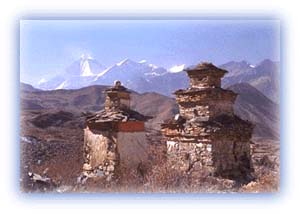Nepal Himalayas
General Info
· Solo Khumbu
· Namche Bazar
· Thyangboche
· Pangboche
· Kalapattar
· Pheriche
· Buddhism in Khumbu
· People: Sherpas
· Mount Everest
· The Quest for Everest
· Early Years
· The 1950s
· Sherpas on Everest
· Central Nepal
· Mustang
· Jomsom
· People: Thakalis
· Manang valley
· Bryagu village
· Manang village
· Nyasang Division
· Western Nepal
· Jumla
· Sukhadik
Photo Feature:
· Annapurna region
High Altitude Sickness
Endangered Species
Protected Areas
Yaks
The Yeti Factor

![]()
|
Muktinath Muktinath, situated at a height of 3,660 m, is an important pilgrimage center for both Hindus and Buddhists. The most prominent shrine is a Vishnu temple where 108 spouts, fashioned in the shape of cows' heads, pour forth water that is considered to be holy. This water is channeled from a stream running above the temple. The temple is built in Tibetan style and contains huge brass idols of Vishnu, Shiva, Brahma, and Kali. |
Nearby is another temple where water gushes out of a rock and this water is considered even more holy. There is also a Buddhist gompa (monastery), and a pagoda-type temple dedicated to Jwala Mayi (goddess of fire). In this temple, shielded by curtains, are the outlets for the natural gas that oozes from the rock and feeds the temple flame.
 |
| View of Dhaulagiri peak from Muktinath Credit: Geert Desmet |
There is also a spring close by. These three elements together are considered to be an auspicious convergence of earth, fire and water.
There are two temples of note, a dilapidated temple with the idols of Lord Shiva and his consort Parvati, and a Narsingh temple where rituals are performed according to both Hindu and Buddhist customs. Here the two religions coexist together and in the two-storey structure, the lower storey is the gompa while the upper storey is the temple.
Muktinath and its high valley are located in the Mustang Bhote region. The climate and landscape here are similar to those of the Tibetan Plateau since it is situated in the rain shadow of the Greater Himalayas. Flowing through the region from north to south and forming deep gorges is the Kali Gandaki river, which as its name implies (kali = black) is a black river -- the black stones of the riverbed and black soil contributing to the effect.
All rights reserved